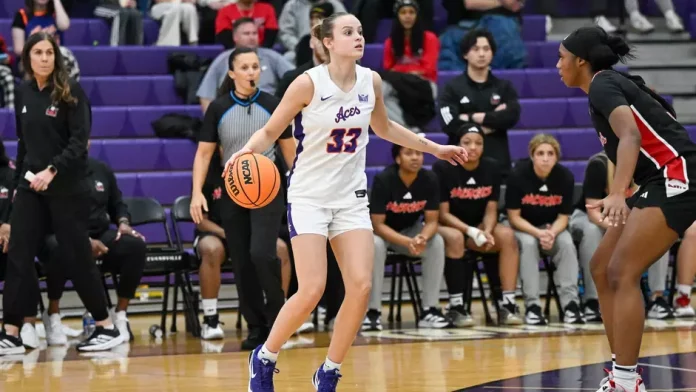|
HOT JOBS
EPD DAILY ACTIVITY REPORT
FOOTNOTE: EPD DAILY ACTIVITY REPORT information was provided by the EPD and posted by the City-County-County Observer without opinion, bias, or editing.
Third Quarter Surge Helps Aces Down Northern Illinois
EVANSVILLE, Ind. – Playing their second home game of the season on Sunday afternoon, the University of Evansville women’s basketball team used a big third quarter to take down Northern Illinois by a score of 65-52 and move to 2-0 at Meeks Family Fieldhouse this season.
Logan Luebbers Palmer (Union, Ky./Randall K. Cooper) continued her strong play with 19 points, marking her sixth consecutive double-digit scoring performance and third consecutive game scoring 15-plus points. Camryn Runner (Cicero, Ind./Hamilton Heights) also finished in double figures with 10 points while adding six rebounds and five assists.
It was a defensive battle in the early going, with NIU taking a 7-2 lead into the game’s first media timeout. Freshman BreAunna Ward (St. Louis, Mo./John Burroughs School) got the Evansville offense going in the final three minutes of the first quarter, scoring six consecutive points to give the Aces a 10-9 lead after the first 10 minutes of play.
With 8:11 to go in the second quarter, Runner drilled a triple to open a five-point advantage at 15-10. However, the Huskies answered back with five unanswered points to even things at 15. The game continued to go back-and-forth for the remainder of the half, with Lubbers Palmer scoring five points and Runner adding four free throws to help give the Aces a 26-24 advantage heading into the halftime intermission.
Evansville got hot coming out of the gates in the second half, starting with a layup from Georgia Ferguson (Waterloo, Ontario/Cairine Wilson Secondary School) on the Aces’ first possession of the third quarter. From there, Luebbers Palmer took over, scoring nine consecutive points to help her team to an 11-2 run and a 37-26 lead with 6:01 remaining in the quarter. Following a three minute scoring drought, Lubbers Palmer added a layup and a free throw to bring her total for the quarter to 11 points.
Holding a 44-31 lead heading into the fourth quarter, Evansville kept their foot on the gas with another layup by Luebbers Palmer and a pair of baskets from freshman Daniela Llavero (Malaga, Spain/IES Mediterráneo) to make it 50-35 with 8:10 left. Fellow freshman Sydney Huber (Cedar Rapids, Iowa/Mount Vernon) added five quick points to increase the lead, before three-pointers from Jelena Savic (Melbourne, Australia/Kurunjang Secondary College) and Kaiden Kreinhagen (Indianapolis, Ind./North Central) increased the lead to 65-46 with a minute and a half to go and put the cherry on top of the win.
“Pumped about the win,” said Head Coach Robyn Scherr. “It was nice to be back home. Really proud of our girls, especially for coming out and opening up the third quarter with a run to create some separation.”
“I thought we had a really balanced game. We saw a lot of players put points on the board. Everyone is a threat out there, and that’s what I expect out of this team. I feel like every single one of our players has the ability to put the ball in the net.”
“Great crowd today here in Meeks, and I am very pleased!”
Evansville was excellent defensively in the win, posting season bests in points allowed (52) and field goal percentage (33.3%). 12 Aces saw the floor in the game, with 11 entering the scoring column.
Screaming Eagles fall in overtime battle against Northern Kentucky
HIGHLAND HEIGHTS, Ky. – University of Southern Indiana Women’s Basketball and Northern Kentucky University added another classic battle between the two programs on Sunday afternoon, but the Screaming Eagles fell on the road in overtime against the Norse, 77-71.
The two former Great Lakes Valley Conference rivals were meeting for only the second time as Division I foes on Sunday, as Northern Kentucky (3-6) made the trip to USI (4-2) last season. On Sunday, USI Women’s Basketball made its first trip to Northern Kentucky since 2012, which was the final year with both schools in the GLVC before NKU made its jump to the D-I level.
In Sunday’s tilt, USI shot for 40 percent (28-70) from the floor and nearly 36 percent (5-14) from beyond the arc. Meanwhile, Northern Kentucky shot just below 36 percent (24-67) overall and just over 38 percent (13-34) from three-point range. The Screaming Eagles outrebounded the Norse, 47-41, and outscored NKU in the paint, 40-18.
Four Screaming Eagles scored in double figures, with two Eagles notching double-doubles. Junior forward Chloe Gannon led USI with a career-high 21 points and matched a career-best 12 rebounds for her first double-double of the season and second in her career. Junior guard Sophia Loden logged her second consecutive double-double and third of the season with 15 points and a career-high 13 rebounds. Junior forward Amiyah Buchanan nearly had a double-double with a season-best 13 points and eight boards. Senior guard Ali Saunders tallied 12 points, dished out seven assists, and had five steals.
Sunday’s game went back and forth despite USI jumping out to a quick 7-0 lead and holding the Norse scoreless for nearly the first four minutes of the contest. While Northern Kentucky closed the early deficit, Loden drained a pair of threes in the early minutes to give USI a 12-7 lead halfway into the first quarter. The Norse answered to grab a 19-14 lead, but Loden connected twice inside of two minutes left in the first to bring the Eagles right back. USI led the early shootout, 22-21, through the opening period.
The game turned into a defensive battle in the second quarter with neither side able to score until the seven-minute mark. A couple of makes by Saunders and junior forward Maddy Fay helped push USI’s lead to five. However, Northern Kentucky stayed within arm’s reach. Despite the Screaming Eagles maintaining a five-point advantage, 32-27, with three minutes to go in the first half, USI went scoreless for the rest of the half. Northern Kentucky was limited to only three points inside the final three minutes of the first half, as USI led 32-30 at the break.
USI relied on its post play in Buchanan and Gannon to start the second half, but the Norse stayed neck-and-neck with the Eagles with their three-point shooting. Northern Kentucky took a 43-39 advantage just past the midway point of the third quarter. A few more inside looks by the Eagles, including a couple more by Buchanan and Gannon, helped propel USI back in front, 48-47, at the end of the third frame.
The two sides matched made shots in the first five minutes of the fourth quarter before Northern Kentucky surged to a five-point lead, 58-53, with five minutes to go in the period. A three-point play by Gannon brought it back to a two-point contest. Loden drilled two jumpers with under 4:30 remaining, but the Norse continued to answer. With under two minutes left, Saunders netted a triple and Gannon scored a basket inside to tie the game up at 66, as the battle went into overtime.
In the extra session, NKU claimed the lead nearly three minutes into overtime, leading by as many as two, 71-69. USI earned its way to the free-throw line to knot the game back up, 71-71, with under a minute remaining. However, Northern Kentucky scored on a layup and converted its ensuing free throws to close out the game.
The Screaming Eagles will continue their road set next Saturday at 3 p.m. CT against East Tennessee State University in Johnson City, Tennessee. Next Saturday’s game can be seen with a subscription to ESPN+ and heard on The Spin 95.7 FM.
Joint Narcotics Investigation Seizes Pounds of Illegal Narcotics
On 11/30/2025 detectives with the Evansville Vanderburgh County Drug Task Force arrested Keonta M
Barton (48) and Andre T Sherman (47) on multiple narcotics dealing charges. Barton was stopped for a traffic
violation where an EPD K9 alerted to the presence of the odor of narcotics inside Barton’s vehicle. A search of
the vehicle found nearly .25 pounds of cocaine and 1 pound of marijuana. Detectives then executed a search
warrant on Barton’s residence. Inside the residence nearly 2 pounds of cocaine was seized, as well as more than
30 pounds of marijuana. Additional evidence of narcotics dealing was located inside the residence. Barton was
charged with Dealing Cocaine and Dealing Marijuana.
As a part of this investigation, detectives also stopped Sherman for a traffic violation. An EPD K9
alerted to the presence of the odor of narcotics inside Sherman’s vehicle. Sherman was found to have more than
5 pounds of marijuana and a firearm in his possession. Sherman was charged with Dealing Marijuana.
PIO Sergeant Anthony
Hoosier Poultry and Egg Farmers Help Ensure Protein Available at Indiana Food Pantries
Gov. Mike Braun, Lt. Governor Micah Beckwith and Indiana State Department of Agriculture Director Don Lamb gathered at the Indiana Statehouse with poultry and egg farmers representing the Indiana State Poultry Association (ISPA) for the 78th annual Governor’s Poultry Presentation.
The event recognized the efforts of Indiana’s poultry and egg companies to ensure those experiencing food insecurity have access to nutritious poultry and eggs at food pantries across the state. It also highlighted the work those companies do to support charitable organizations in their communities.
Poultry and eggs are always in demand at food pantries across the state. Over the past year, $620,000 worth of chicken, duck and turkey have been donated to Indiana food banks and community organizations by Indiana poultry producers to help Hoosiers in need. Indiana egg producers have also provided 833,000 dozen eggs to their Hoosier neighbors, with an additional 1 million dozen being distributed across the nation.
Beyond giving of their poultry products, poultry companies provided in excess of $650,000 in direct contributions to various non-for-profit and charitable organizations.
“Indiana’s poultry and egg farmers are a vital part of our state’s economic strength,” said Gov. Mike Braun. “Their leadership in supporting communities and stepping up for their neighbors make a real difference across Indiana, and I’m proud to recognize their continued generosity and commitment.”
The ceremony also included reflections on the size of Indiana’s poultry sector. Indiana is one of the top poultry-producing states in the country. According to the USDA National Agriculture Statistics Service, Indiana ranks first in duck production; third in egg production; fourth in turkey production; and notes its broiler chicken production as well. Indiana’s size across multiple poultry sectors is unique in the country. Further, it contributes over $18 billion in total economic activity, and it directly employs more than 12,700 Hoosiers.
“I grew up working with my dad in the dairy industry, so I know the kind of grit it takes to feed people,” Lieutenant Governor Beckwith said. “Our poultry and egg farmers show that same kind of commitment in Indiana, but they also demonstrate Hoosier hospitality through their generosity.”
ISPA President Rebecca Eifert Joniskan shared, “Poultry farming in Indiana is a family affair. The companies represented here today all started as small, family-owned operations, committed to producing quality products. They know families cannot thrive without healthy food, and they are humbled to be able to make a difference in the lives of other Hoosier families.”
The poultry and egg products on display today were donated to Second Helpings, a hunger relief agency in Indianapolis. The ceremony marks an annual tradition that dates back to the late 1940s. Organized by ISPA, one of the oldest poultry organizations in the nation, it was designed to celebrate the strength and generosity of Indiana’s poultry farmers, as well as the annual donations made by its members, who are responsible for more than 95% of the chicken, duck, turkey and eggs produced in Indiana.
Vanderburgh County Board of Commissioners Meeting
DRAFT AGENDA
Vanderburgh County Board of Commissioners
December 2, 2025 – 9:30 a.m.
Room 301, Civic Center Complex
1. Call to Order
2. Attendance
3. Pledge of Allegiance
4. Action Items
A. Engineer
1. 2. 3. Financial Commitment Letter for Indiana Department of Transportation (INDOT)
Community Crossings Matching Grant Application: Darmstadt Road Bridge #400
Change Order #13: Oak Hill Road Reconstruction
Indiana Department of Transportation (INDOT) Report of Contract Final
Inspection and Recommendation for Acceptance
i. Oak Hill Road Reconstruction
ii. Boonville-New Harmony Bridge #252
B. Auditor
1. C. Burdette Park
1. D. Clerk
1. 1. Service Agreement with Nyhart Company, Inc.
Three i Design Proposal for Restroom Building Design Services
Collection Agreement with Eagle Accounts Group
E. Superintendent of County Buildings
Amendment #2 to Old Courthouse Lease Agreement: David Miller and Zach
Evans
2. Old Courthouse Lease Guaranty and Agreement: Kristen Elise Photography
F. 2026 Contractual Services Agreement with Purdue Cooperative Extension Service
5. Department Head Reports
6. New Business
7. Old Business
8. Consent Items
A. Approval of November 18, 2025, Board of Commissioners Meeting Minutes
B. Employment Changes
C. Auditor
i. 1. Claims Voucher Reports
November 17, 2025 – November 21, 2025
November 24, 2025 – November 28, 2025
ii. D. Circuit Court
1. Surplus Request
E. Engineer
1. Report and Claims
F. Superintendent of County Buildings
1. Amended Amendment #3 to Old Courthouse Lease Agreement: Laura Symon
d/b/a Into the Light Mental Health and Consulting Services, Inc.
Drainage Board Immediately FollowingG. Treasurer
1. October 2025 Innkeeper’s Tax Report
H. Board Appointments
1. Board of Examiners of Construction and Roofing
i. D.G Asay
ii. Matthew Pruiett
iii. Peter Winzeler
2. Burdette Park Advisory Board
i. Christen Mogavero
ii. Denise Peyronnin
iii. Kyhle Moers
iv. Ryan Kremer
3. Evansville-Vanderburgh County Emergency Management Advisory Council
i. Deavron Farmer
ii. Noah Robinson
4. Vanderburgh County Redevelopment Commission
i. Hobart Scales
ii. Wayne Kinney
9. Public Comment
10. Adjournment
12. Members of the Vanderburgh County Board of Commissioners
i. Justin Elpers, President – District 2
a. Term: January 1, 2023 – December 31, 2026
ii. Amy Canterbury, Vice President – District 3
a. Term: January 1, 2025 – December 31, 2028
iii. Mike Goebel, Member – District 1
a. Term: January 1, 2025 – December 31, 2028
Drainage Board Immediately Following
G. Treasurer
1. October 2025 Innkeeper’s Tax Report
H. Board Appointments
1. Board of Examiners of Construction and Roofing
i. D.G Asay
ii. Matthew Pruiett
iii. Peter Winzeler
2. Burdette Park Advisory Board
i. Christen Mogavero
ii. Denise Peyronnin
iii. Kyhle Moers
iv. Ryan Kremer
3. Evansville-Vanderburgh County Emergency Management Advisory Council
i. Deavron Farmer
ii. Noah Robinson
4. Vanderburgh County Redevelopment Commission
i. Hobart Scales
ii. Wayne Kinney
9. Public Comment
10. Adjourn
Indiana cigarette consumption down, quit program enrollment up after tax hike
Cigarette consumption in Indiana dropped 40% during the first three months of a long-sought tax increase, according to the Indiana Department of Health. Enrollment in the agency’s smoking cessation program jumped almost 40% over that time.
“(Cigarette) use impacts, really, every aspect of health,” said Miranda Spitznagle, director of IDOH’s Division of Tobacco Prevention and Cessation. But it’s a risk factor that is “fully preventable.”
Using taxes to raise the price of tobacco helps current users quit and may dissuade others from starting, Spitznagle said.
“It’s a huge policy factor for public health,” she added.
State legislators stuck a $2-per-pack hike into the two-year budget, House Enrolled Act 1001. They also proportionally increased taxes on electronic cigarettes and other tobacco products.
Spitznagle said that across-the-board approach prevents users from switching products instead of quitting or pulling back.
“This year, Indiana lawmakers stood up to Big Tobacco” by boosting the taxes, said Allie Kast Gregg, government relations director for the American Cancer Society Cancer Action Network.
But public health wasn’t the only motivation.
The Indiana Senate resisted for years, but in the wake of a dismal budget forecast, agreed to include the hikes in the budget’s final draft.
The boost to a nearly $3-a-pack tax on cigarettes went into effect July 1. And it is already paying off.
Indiana has collected $188 million in cigarette taxes from July through October, according to the State Budget Agency’s latest monthly revenue report. That’s almost three times the $68 million earned over that time period last year.
IDOH used the first three months of data — July, September and October — to calculate a 40% drop in consumption.
Meanwhile, Hoosiers are flocking to the state’s cessation help program, Quit Now Indiana.
“The month of July specifically, we doubled our enrollments,” Spitznagle said, compared to that month last year.
Participation was up 38% over those first three months, rising from 620 to 1,241 people.
Quit Now Indiana is up to eight times more effective than solo efforts, Spitznagle noted. Going it alone has a single-digit success rate, while the state program has a 32% quit rate.
“What Quit Now Indiana offers is multiple touch points with a trained quit coach who knows how to talk through and make a quit plan … that understands nicotine addiction,” she said.
The program can also provide two weeks of nicotine patches or gum and helps enrollees see if their employers or health plans can offer further medical support.
The American Cancer Society also runs an email-based Empowered to Quit program.
Nearly 15% of adults in Indiana smoke, according to U.S. Centers for Disease Control and Prevention data from 2023.
Thousands of Hoosier deaths annually are attributable to smoking. An oft-cited CDC estimate from 2014 places the death toll at 11,000 a year.
Spitznagle said that for every one death, however, 30 people live with chronic health conditions linked to their smoking.











